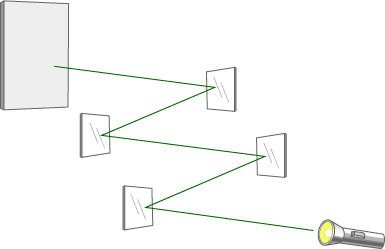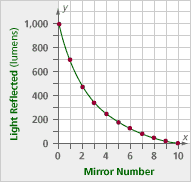Join us for conversations that inspire, recognize, and encourage innovation and best practices in the education profession.
Available on Apple Podcasts, Spotify, Google Podcasts, and more.
You’ve already seen examples of exponential growth. When you have an exponential function where the constant multiple between outputs is less than 1, you have a decreasing function. Instead of exponential growth, you have exponential decay. Here’s an example:
The brightness of a light can be described with a unit called a lumen. A certain type of mirror reflects 3/5 of the light that hits it. Suppose a light of 2,000 lumens is shined on a series of several mirrors.

Complete the table to indicate how much light would be reflected by each of the first three mirrors. (Mirror 0 represents the original light.)
Problem H2
One mirror in the series reflects about 12 lumens of light. What mirror number is it? How did you find your answer?
Problem H3
Which mirror number reflects about 1/10 the original amount of light? Does it depend on the starting amount of light?
Problem H4
The graph below shows the amount of light reflected by another series of mirrors. The amount of light reflected by this type of mirror is different from the amount reflected by the other mirrors you investigated. The intensity of the light being shone on the first mirror is also different.

Problem H5
Suppose you have the function y = (1/5)x.
Problem H1
Here is the completed table. One formula is L = 2,000(0.6)m.
|
Problem H2
The best way to do this, without using more advanced math such as logarithms, is to continue following the table. This is particularly easy with a spreadsheet. The 10th mirror will reflect about 12 lumens.
Problem H3
We’d be looking for the mirror that reflects closest to 200 lumens, which is the 5th mirror (156 lumens). The 4th mirror reflects 259 lumens; this does not depend on the starting amount of light. This means that the 6th mirror reflects about one-tenth the light of the first mirror, the 7th mirror reflects one-tenth the light of the 2nd mirror, and so on.
Problem H4
Problem H5